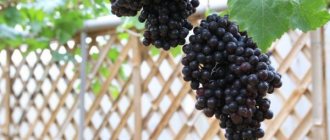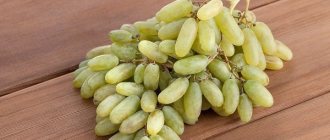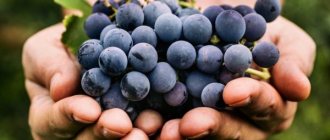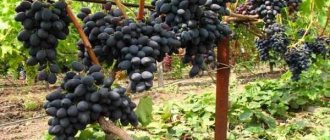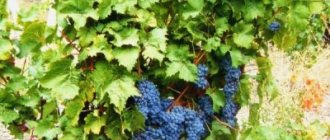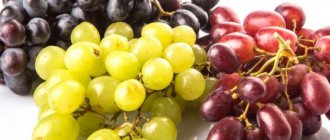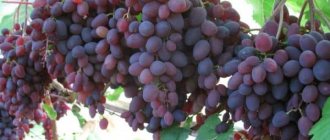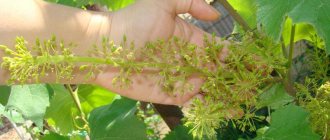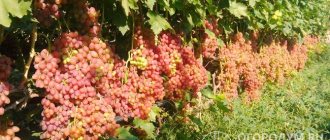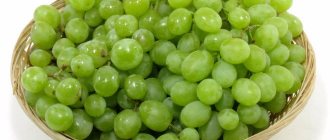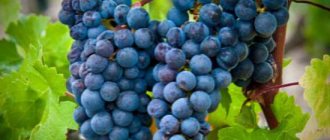Description of the grape variety Kishmish black
Grapes are one of the most common crops cultivated throughout the world. The healthy and very tasty berries of the plant are consumed fresh, and not only. Delicious juices, wines and dried fruits are made from grape fruits. Every year, breeders delight gardeners with new products, developing new hybrids that are easy to care for, have high yields, and are resistant to adverse weather conditions and various diseases. One of these is the black raisin grape variety. We bring to your attention a detailed description and agricultural technology of this crop, as well as its varieties.
Description of the variety
This seedless crop was developed on the Central Asian continent. For more than one year now, breeders of the Institute named after. Potapenko are developing new hybrid forms of this variety. Kishmish black Potapenko belongs to the mid-season species.
The bushes are distinguished by strong growth vigor with good ripening of shoots. The leaves are medium sized, three-lobed, round in shape, dark green in color. The bunch is cylindrical or cone-cylindrical in shape, medium in size with an average degree of looseness. In the photo of the black raisin grape variety you can see how attractive and appetizing its clusters look.
The berry is not large in size and has an oblong, slightly flattened shape. The color of the berries is deep blue. The skin is thin, covered with a light waxy coating. The pulp of the fruit is very juicy and sweet in taste.
The black raisin grape variety ripens four months from the beginning of the growing season. This species is of great value to consumers due to the excellent taste of the fruit. The harvest is not only put up for sale, but is also used to make dried fruits, aromatic wines and healthy soft drinks.
The only drawback of this hybrid is its low resistance to diseases such as anthracnose and oidium. In addition, black sultana grapes are often damaged by leaf roller. Kish mish black Potapenko is slightly resistant to frost. Therefore, in the middle zone and in the Urals, it is grown as a cover crop.
Black finger
Black Finger is undoubtedly the best hybrid of this group. Just take a look at the photo of the Kishmish Black Finger grape variety and you’ll understand why. This is the only large-fruited seedless variety from this group that was developed by Israeli breeders. It is believed that this is a genetically modified species. The description of the Kishmish Black Finger variety includes the following characteristics:
- large fruit;
- amazing taste and excellent presentation of the berries;
- high sugar content - over twenty percent;
- high yields and massive bunches - from one to one and a half kilograms with good care.
- In subsequent years of cultivation, the weight of the brushes can reach two kilograms.
The photo of this variety cannot be confused with other newly bred species of the progenitor.
This black sultana is not resistant to frost and this is its main drawback. This culture can withstand temperatures down to -20 degrees. Therefore, in the North and regions of the middle zone it needs protection during harsh winters.
Features of the hybrid
The harvest ripening period falls in the month of August - approximately 150 days after the beginning of the growing season.
The fruits do not contain seeds. The fruits are large, oblong, reaching fifteen grams in weight. Under the thin dark blue skin there is dense, crispy flesh with a slight nutmeg flavor. Cysts are large, loose, and often have the shape of an asymmetrical cylinder.
Black finger raisin grapes are very healthy: its fruits contain large amounts of sucrose and fructose, so it is recommended to consume it fresh.
Entire plantations are planted with black finger raisins, since this crop is intended specifically for large-scale cultivation. This hybrid is a late-ripening species; the crop's resistance to diseases is below average.
The harvest is transportable over long distances and has an excellent appearance.
Useful properties of berries
Despite the fact that this grape variety bears small berries, its benefits are very great. Delicious raisins are made from grape fruits. And as you know, dried fruits contain a large amount of vitamins and nutrients, which were told about by the ancient healers of the East and Asia.
Just one handful of steamed raisins, made from grapes, helps eliminate throat irritation and cough. But that’s not all that these grapes are good for. The fruits of black grapes, Kishmish Potapenko, contain large amounts of fructose, sucrose and glucose.
Black raisin grapes contain vitamin A, C, B vitamins, and nicotinic acid. And only dark varieties of black sultana have such beneficial properties.
Calorie content
How many calories are in one hundred grams of berries? The calorie content of some types of fruit can reach 400 kcal per 100 grams of product. Calorie content with this indicator indicates that the fruits of the sultana grape are rich in sugars and glucose.
By regularly consuming grape fruits, you can replenish the lack of glucose in the body and increase immunity due to this complex of vitamins.
Is there any harm in the fruits of these grapes? Here the answer is clear - absolutely nothing, complete benefit!
Related Article: Determination of Maturity - Research on Grape Ripening - Grapes
This grape became the basis for the development of new hybrid forms. Let's consider their detailed description and characteristics.
The benefits and harms of seedless grapes
Kishmishi have a pleasant taste and a high content of vitamins.
- helps improve immunity;
- improves mood, saves from depression;
- removes harmful toxins from the body;
- improves blood counts;
- gives a good effect in the treatment of colds;
- promotes rejuvenation.
An excellent dessert is made from sultana berries, and preparations are made (raisins, marinades, jams, marmalade). A number of varieties are used to make wine, liqueurs, and juices.
- due to the high sugar content, grapes without seeds are contraindicated for people with certain diseases (stomach ulcers, pancreatitis, diabetes mellitus);
- with excessive consumption of sweet grapes, diarrhea, flatulence, and indigestion occur;
- grape juice worsens the condition of tooth enamel, so it is recommended to rinse your mouth after eating;
- calorie content is 60-100 kcal per 100 grams, so for those who are overweight and prone to obesity, it is advisable to exclude berries from the menu.
There are few contraindications; if the recommendations are followed, there will be no harm to the body.
Black Sultan
This culture was obtained by combining two hybrids - Glenora and Talisman. This is a table form that does not require pollination and is characterized by early ripening of fruits. The leaves of the black sultan raisin are small and round. The bushes grow and develop quickly.
The fruits of the black sultan raisin ripen 120 days after the vegetative buds open. The weight of the fruiting brush is average and varies between 500-700 grams. The clusters have a cylindrical-conical shape with good fruit density. The skin is of medium density, but when eaten it is practically not felt. One berry weighs on average 5 grams. The fruit has an oblong shape, blue color with a characteristic waxy coating. A distinctive feature of this variety is the excellent fruity taste of the pulp.
Black Sultan Kishmish does not require special conditions for care and cultivation, therefore it is cultivated in many regions of the country, including in the middle zone.
The Sultan hybrid is used for cultivation in both private and industrial viticulture to produce delicious wines, juices, fresh consumption and the production of dried fruits.
Description of the variety Kishmish black
Black Kishmish grapes can also be found under the names Kara Kishmish, Black Monukka or Kishmish Sio. It ripens in early to mid-season, and its external characteristics are described below.
Appearance
The characteristic features of the variety are:
- vigorous bush;
- leaves are three-lobed, strongly dissected, medium in size;
- The color of the leaves is dark green, the underside is pubescent;
- bisexual flower;
- clusters of medium size, conical and cylindrical-conical, medium loose;
- bunch weight up to 700 g, berry weight 2.7–3 g;
- the berries are oval, black with an abundance of waxy coating;
- the pulp is dense and crispy, with a thin skin, without seeds or rudiments;
- The taste is excellent, sugar content is 22–27%.
Advantages and disadvantages of grapes
- The recognized advantages of the variety are:
- high yield, up to 250 c/ha;
- good ripening of the vines;
- excellent taste characteristics;
- using berries for drying.
- The main disadvantages of the variety are:
- low frost resistance;
- susceptibility to oidium, anthracnose;
- affected by grape budworm and wasps.
Advantages of the variety
The advantage of Kishmish Black Sultan is its resistance to mildew, oidium and gray rot. Fruit buds can withstand frosts up to 25 degrees. Thanks to its dense clusters, it can be easily transported without worrying about spoilage of the fruit. The yield of the variety is quite high: up to 100-250 c/ha.
The bushes develop well and are not very whimsical, so you can buy Black Kishmish without hesitation for planting in your country house or garden plot.
It is recommended to plant Kishmish grapes in a spacious, sunny area without drafts.
Another advantage is the simple care of the bushes, which consists of watering and fertilizing. It is also better to protect the shoots from frost for the winter. It is believed that it is the black varieties that are most useful. Eating it helps lower cholesterol levels and strengthen the cardiovascular system. The skin of the fruit consists of substances that prevent the formation of blood clots. Berries are rich in antioxidants that prevent aging of the body. Fine red wine is made from black grapes. Kishmish fruits are often used to produce raisins.
- Author: Maria Sukhorukikh
Rate this article:
- 5
- 4
- 3
- 2
- 1
(0 votes, average: 0 out of 5)
Share with your friends!
Composition of sultanas
Black Kishmish berries contain:
- 17.4% carbohydrates;
- 0.7% protein;
- 0.7% fat.
Grapes are rich in minerals and vitamins; they contain:
- calcium, potassium and iron;
- vitamin C, A, group B, E and K.
The calorie content of seedless grapes ranges from 65 to 75 kcal per 100 g of fresh berries. The juice of sweet berries has a low acidity of 4-5 g/l.
Application of sultana berries
Kishmish berries are very tasty fresh. After special drying, you can obtain raisins, which are subsequently used for baking and preparing other culinary dishes. Kishmish is used to make candies, jam, and added to drinks.
Several methods are used for drying in the garden. One of the oldest methods of “aftobi” was used specifically for Black Kishmish in its natural habitat, where the berries had time to dry without treatment before the rainy season. The bunches are laid out on a wooden base in a thin layer and dried for about 18–20 days. At a humidity of 18%, the yield of quality products is up to 25%.
In its pure form, sultana wine is almost never made, but the berries can be part of a blend for wines such as port, Cahors and other dessert types.
Related Article: History of California Vineyards - Grapes
Features of cultivation and care
Knowing the characteristics of growing a particular variety, you can get more quality berries. Black raisins require mandatory shelter for the winter, as well as a certain method of pruning.
Landing
High growth rates imply planting in a spacious area, with a minimum interval of 2.5 m between bushes or other large plants.
Kishmish is demanding of heat and sun and should not grow in a place blown by cold winds. The optimal choice would be a site on a southern slope. The presence of a nearby wall or fence that does not block the sun will increase the amount of temperature due to the release of heat by the surface at night.
It is better to plant a heat-loving bush in the spring so that the roots of the plant take root well over the summer. The main requirement is complete coverage of the roots with soil.
Bushes of this variety tolerate drought well and do not require abundant watering. To achieve maximum sweetness, watering is completely stopped 2-3 weeks before harvest.
Check out other varieties of sultana grapes:
Organic or mineral fertilizers in liquid form are applied throughout the growing season, but nitrogen supplements are eliminated from mid-summer. Once every 2-3 years, complex mixtures are added in the spring.
The molding of a grape bush should provide for the possibility of winter shelter, so most often they use inclined cordon forms or fan-shaped options with long pruning of fruit shoots. The variety is prone to severe pinching, and therefore requires constant breaking of unnecessary green parts.
Preparing for winter
After harvesting and autumn pruning, the bushes are treated with solutions of iron or copper, cleared of fallen leaves and covered in dug trenches. The tied vine is laid to a depth of about 20 cm and covered with soil in a mound of up to 30 cm.
Forum statistics
207036 Messages in 1634 Topics from 5593 Users. Last user: Amaya Last message: “Let's talk about the weather in Vash...” ( Today at 07:52:22 ) Latest messages on the forum.
Now on the forum
39 Guests, 13 Users
Users in the last 15 minutes: vlad51, gardener, Kenig, Nikolay 2, marlin64, rambo, Vasily 53, ALEX, Elvira2017, 77volt, Evgeniy52, kvg, ElenkaF [Blocked] [Section Moderator] [Forum Moderator]
Maximum online today: 100 . All-time maximum online: 2758 (28 July 2021, 17:22:51)
Users who visited the forum in the last 24 hours
Total: 295
(Visible: 294, Hidden: 1) 1963, gardener, vlad51, Kenig, Nikolay 2, marlin64, Vasily 53, rambo, ALEX, 77volt, Elvira2017, kvg, Evgeniy52, ElenkaF, sergei, Ser, Evgeniy 163, Lyubov S., Erem, Polyanina Ekaterina, kosmos, Yura, GALINA ANOKHINA, DorontsovPeter, ZaycevAS, Alex65, 64nikolay64, Vova Kapran, zsb, Polina77, spotlight, Mikhail Alekseevich, Svetla777, Quiet, Marshal, Nikolay S., therapist, Liza, Capricorn, lomakin1969, Alexander Vl., Andrey76, Slavka, Mikhail77, Tatyana B, Cherkessk, Eugene, leonidych, vladimirM, yotmast, mers, Serg1707, SNovichek, hanter64, znakomij, Alexander K, Vardan, Sergey Fer, Anatoly Sivkov, Alexey V, Ilya 77, Andrey Gladilin, Tatyana A., Belgorodets, in Astrakhan, Oksana Kopp, sem_en, Vladimir 153, skier, Igor Viktorovich, slavalimon, Primorets, OlgaOs, SANYCH, 31rus, mystic69, Andrey Tsvetkov, Buba, igor222, Elena Z, Nikolay Rex, Sergey 1965, Vladimir Buturlakin, DSW, psv1960, Dmitry 77, Vasily V., Vyacheslav03, Natalia Nikolaevna, Sergey Tashchiyan, Igor Sergeevich, alexsandr, Pioneer, nicson7, Elena Aleshchenko, Alexander-ask-34, Verona, Igor F., Taker , Henry, Yuri72, L.A.P., Gaivoronsky Yuri, Sergeevich, Sergei Chistokletov, Svetlana Streletskaya, Galinka, Alexey Deminov, Naumov Igor, Vyacheslav136, Gloomy, Katrin, AndSanych, Mikhno Alexander, Ded31, Filippov Oleg, Vladimir ++ , Lydia58, ALEXANDER BRYANSKY, Vladimir-kanevskaya, DIL, Amber7394, Marina Protasova, TITOVA LYUBOV, Linx, alexander66, Natalya M, Mikhail Fesenko, Amaya, Alexander71, Boris 1952, tsv, Maximilian, 25nata35, nadia, Igor_K, Alexander Kolesnikov , Ivan Levin, Pitko, weather forecaster, eSAa, cecet71, atseton, Alexander Smirnov, Vladimir Kostochkin, Vladimir Berdnikov, Gocha, pioneer-2, LeXa_KoT, Sergey 61, Sergey Yuryev, alexss, Skif, Vladimir Kovba, dayton, Yuri Semyonov, N. A. Sokolov, Pavlentiy, Sa-shura, Volgogradka, Dmitry Anatolyevich, Grandfather Igor, Andrey Lis, Bublichenko Alexander M, Marina Krymskaya, stenlly2010, irahelm, Vyacheslav Vladimirovich, Vladimir Shilov, Aprel, Badaev Dmitry, gheo55, y_fed, Yagodka, Valentina Ivanovna, Kryn, oleg9f, DED2, Svetlana Korotina, Oleg Ivanovich brought in, Eduard., santra, L2k2m7n, Alexander48, Viknik, Andrey 31, m2d, Valery Rastorguev, Soshnin Yura, Amateur gardener, Galina, Vasily1111, Salex, Sergey Ko, Ramiz, Victor_, potap05, Yuri 36, VitalySD, Inna161, Vladimir Shcherbinin, Valerie, niy1, cfibr, Andrey68, kulol3, thanatos, Serzh1978, Realist, Artur53, max2008-01, LOZA, AlexanderD, Ded Young, Natasha, Zayac, ketch , Rita, alx-74, Iv Iv, Alexander150, Igor K, Vasily Viktorovich, VeraNiK, kdm57, Veniaminovich, Boris Sokolyansky, , vikbublik, neposny, Evgen, Victoria Aleksandrovna, Serezha 64, Wintel, Airbone, teri, Sergey Lomonosov, Khramov , serzhinio, Leonty Yarygin, Irina O., Nadezhda Grig, netolya, Saisan, Alexey Agryzkov, Vadi, Zinaida, Vadim, Alexander Taganrog, Sergey Sukhonos, Snezhinets, evgen_26, nau_63, Masha_sadovod, Gennady163, krasnovlad1, Alexander Zinoviev, Roman Fedorovich, TIS, Alexey Sergeevich, arnyusha, Zheka, Nurtas, kradievska, nick041, Valentina Medvedeva, Sergey43, Andrey S., Nikolay Lipunov, Mst, Vertuoz2, Vladimir VS, NatalyaMed, freesia, Kinna, Mikhail Michurinsk, alekcsan1, VALERY TAMB, Sasha57, MikhAf, Y_Azer, Andrey Beribesov, hunter1955, nut lover, Keys, Ivan Shmelev, Pestle, anton_slash, Nadymchanka, Sergey 31, Volgar, Pavel 64, Tatyana Volzh, Elektronik_t
Description of diseases and pests
Black sultanas are not particularly resistant and often get sick:
- oidium , which appears on different parts of the bush as an ashy coating with a moldy smell. For protection, spraying with special mixtures is used before and after flowering, then after 20 days and in early August;
- Mildew is a fungus whose spores germinate in wet weather and overwinter in plant debris. Affected leaves have oily spots in shades of yellow, which then dry out and fall off. It is necessary to ensure the bushes are ventilated and damaged parts of the bushes are burned, as well as to treat them with fungicides not only at the specified time, but also during the onset of rainy and warm weather and fog.
The most dangerous pest for sultanas is the grape leaf roller, whose caterpillars feed on flowers and grape ovaries, and then eat the berries. In the event of a butterfly attack, the bushes are treated with insecticides, and the process is stopped 30 days before the berries are harvested.
Wasps love the sweet berries of sultanas. To combat them, you can use insecticides, drive away insects with smoke, set traps and destroy nests. For a small vineyard, individual protection of each bunch with a special fine mesh bag is effective.
Varieties of Black Kishmish
In addition to the oldest black Kishmish, other dark seedless grapes are grown. Brief descriptions of the most common varieties are presented below.
Black finger
An Israeli variety with elongated large berries up to 3 cm in length, weighing up to 14 g. A bunch of up to 1–1.5 kg ripens in about 155 days (late). The skin of the berries is dense, so the berries have good transportability. The taste is harmonious, sugar content from 20%. Frost resistance down to -20°C, requires treatment for diseases.
Black emerald
Early American variety (Black Emerald) with berries 3–5 g and dense pulp. The average weight of a bunch is 500 g. It is characterized by high yield and low disease resistance. Can tolerate down to -23°C.
Related article: Manual for table grape producers - grapes
Black Sultan
An early variety with a tall bush and an average bunch of up to 700 g. Black berries weigh 2.2–2.8 g, with a light fruity aroma. Sugar content up to 24%. Increased frost resistance, up to -25°C. Relative immunity to mildew, gray rot and oidium.
Kishmish Potapenko
The variety is frost-resistant down to -25°C and has an early ripening period. The mass of the bunch is about 500 g with relatively large berries 3-4 g. Sugar content up to 25%. Disease resistance is average.
Black raisin has a long history and is not losing its position in modern homestead vineyards. With timely protection from diseases and winter shelter, the bushes provide a high yield of sweet, seedless berries.
Description and characteristics of the variety
The name Kishmish unites a large group of varieties that have several characteristics.
- The main distinguishing feature is the absence of seeds in the berry. In some hybrid varieties, seeds are still present, but they are so small and undeveloped that they are practically not felt.
- Kishmish clusters are dense or loose with small berries. Color depends on the variety. But, regardless of the variety, the berry has a dense structure and has excellent preservation.
- The pulp has a high sugar content - from 17 to 25%. This makes Kishmish an ideal berry for making raisins.
High sugar content, absence of seeds and dense pulp make Kishmish an ideal variety for making raisins
- Kishmish is a universal grape; it can be classified as a dessert and table variety at the same time. The berries can be eaten raw, dried, made into wine, or made into jam.
- All varieties are excellent pollinators.
- Kishmish is a very healthy food product. The vitamins and microelements it contains help to recover from a serious illness, support the heart muscle, and bring blood pressure back to normal.
This is probably where the general similarities end. Varieties have different ripening periods and frost resistance.
Description
The homeland of seedless grape crops is Central Asia. But for many years Russian breeders from VNIIiV im. Potapenko Ya.I.. The Kishmish Black Sultan variety was developed by crossing Talisman and Glenora. The tests were carried out by specialists from the Institute Potapenko Ya.I. in the south of Belarus. This is a table grape. The leaves of the plant are medium-sized, rounded. The flowers do not need dusting because they are bisexual. The fruits ripen early. The period from the beginning of bud break to the full ripening of the fruit is 115-120 days. The bush develops and grows quite quickly.
The grape bunches are medium-sized, weighing from 300 to 700 g and cylindrical-conical in shape. The bunches and berries are quite dense. But when eaten, the skin is not felt. Each berry weighs approximately 2.5-3 g. The fruits are round or slightly oval in shape, black in color with a slight waxy coating. The pulp of sultanas has an amazing fruity aroma, is very dense and crispy. Sugar levels are around 17-23%. There is also an oval-shaped Kishmisha variety, Black Finger. The variety was bred in the USA, which is why it is also called Blackfinger. Compared to Kishmish Black Sultan, the crop bears fruit in larger clusters of up to 2 kg, and the berries are much larger. The weight of a grape can be from 8 to 12 grams. Productivity is consistently high.
Black finger can be grown in the vast northern regions, since the species is frost-resistant. The plant requires constant treatment with antifungal substances. It will not be so easy to purchase this variety for planting, since it is patented, so you must first buy a permit to grow Blackfinger.
Also, US experts have developed another type of black sultana - Black Emerald. A special feature is the early ripening of berries. The clusters and berries are small, up to 600g and up to 5g, respectively. The grapes are round, taste very sweet and crunchy. The advantage of the crop is resistance to low temperatures, high stable yields.
Origin and cultivation history
"Dried grapes" first appeared in Persian cities. Further, the distribution of raisin grape varieties occurred in Central Asia, so even some oriental fairy tales had references to this fruit. Kishmish is distinguished from other varieties of fruit and berry representatives in the form of very small seeds or their complete absence.
Today, small grapes with fruits of medium sweetness grow almost throughout the entire territory of Russia. Unpretentious and also resistant to frost.
The appearance of a variety is the result of mutation. Gardeners noticed natural “selection” and continued to experiment. The result was a variety of sultana grape varieties:
- Radiant. Ripens within 4-5 months. The fruit has a medium sweet and juicy taste, suitable for making juices and wine. The clusters are large, have a clear cone-shaped shape and are up to 50 cm in length. One bunch contains 800-1000 g. The berries are slightly elongated, and the sultana grape itself is pink.
- Zaporozhye. It is early ripening, characterized by sufficient tolerance to temperature changes. The ripe fruit is harvested in August. The weight of the bunches reaches 800-900 g, but in the southern regions gardeners grow fruit weighing more than 2 kg.
- White. It will take more than six months to fully mature. These are mid-late berries grown in the middle zone. The clusters are medium in size and cylindrical in shape. The weight reaches 250 g. The berries are small amber yellow in color. Grapes with thin lightish skin and slight sourness.
- Rasbol will sing for 5 months. It has a large, elongated shape of clusters that weigh more than a kilogram. The oval berries have a white tint. They are quite large and weigh about 10 g. During consumption, rudimentary seeds may be caught.
- Century. It ripens in the 4th month and is considered a variety of medium ripeness. The plant grows strongly, and the clusters are conical and medium dense.
- Jupiter. It is considered one of the recently bred varieties of sultanas. It was bred in America; ripe berries can be observed after 4 months.
- Hungarian 342 is a dessert plant. It has an early ripening category, reaching its development at 3-4 months. The description of the variety depends on the region of germination, since the weight of the bunch reaches from 500-1000 g.
- Veles has early ripening periods, so after 3 months you can see ripe fruits.
Kishmish is grouped into a varietal group based on similar characteristics:
- Clusters with increased density and medium sized berries. The shade depends on the variety, so sultana grapes are grown red, pink, white or yellow.
- The berries have a dense structure, minimal or no seeds. Only in hybrid varieties the seeds are almost imperceptible, but they are there.
- Grapes with sweet pulp, sugar content of 18-25%.
Advantages of the variety
The main advantages for which this sweet variety is loved:
- begins to bear fruit early;
- high yield, so up to 250 centners per 1 hectare;
- good rooting of cuttings and mature shoots, which allows you to grow berries in harsh climates;
- preservation of taste and presentation during transportation over long distances;
- frost resistance, allowing you to withstand cold down to -28°C without additional shelter;
- berries do not crack due to temperature changes and high humidity;
- the fruits are universal and can be consumed fresh, for winemaking and production of industrial raisins;
- The appearance and stability of sultanas varieties allow the vineyard to be used for decorative decoration.
Disadvantages of the variety
But there are also the following disadvantages:
- if the plant is overripe, it crumbles, so you need to harvest it in a timely manner: after reaching a blue color and filling with juice;
- are not resistant to gray rot, so the leaves need to be treated.
The disadvantages are not so critical if you take care of the plant and harvest it in a timely manner.
It is not recommended to use raisin for certain disorders:
- diseases and inflammatory reactions of the gallbladder;
- pancreatitis;
- stomach ulcer.
The use of the product is contraindicated for diabetes mellitus due to the presence of sugar, which can harm the body. After eating a large amount of fruit, there may be a sharp pain and stomach upset.
Kishmish is not recommended for adults and children with dental diseases. Berries contain large quantities of fruit acids, which damage tooth enamel and cause harm to gums.
Fruits during pregnancy are consumed in reasonable doses, as excess sugar leads to premature or difficult labor. 1 bunch brings benefits.
The name of this variety has Persian roots, and sounds delicious, like some kind of oriental sweet - Kishmish. Literally translated as “dried grapes.” Naturally, the birthplace of this variety is Central Asia. Kishmish was first mentioned in 1212, in an Uzbek fairy tale.
Once upon a time, grapes with very small seeds or with their complete absence appeared on the territory of Central Asia. This happened through natural mutation. The natural experiment was noticed by people and continued. The result of painstaking work was the birth of many varieties of grapes with white, pink or dark berries.
Kishmish is a unique creation of nature, which people have enjoyed using
Kishmish, which has many varieties, is completely unpretentious to grow. In addition, breeders have created types of this grape that are not afraid of low temperatures and produce full harvests even in regions with cold climates. Kishmish can be grown not only for your own table, but also for sale, if you select varieties with excellent shelf life and transportation.
